"Cinnamon Breads, Fresh from your Oven"
October 21, 2010 - Volume 1, Issue 20
|
|
|


Next Issue: Nov 4, 2010
"Stews & Ragus"
|
|
|
Baking Season
| What's better than sliced bread? Fresh bread straight from your own
oven! With cooler weather upon us, it's baking season. Specific flavors
come forward and mark these autumn moments - cinnamon, nutmeg, allspice,
ginger, and clove. Our breads, (and apples, pumpkins, and squash)
hunger for the company of these spices, and our kitchens gladly oblige.
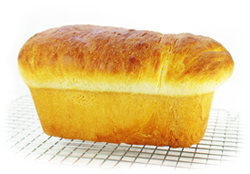 IN THIS ISSUE, we celebrate autumn with a "how-to" on making bread. We delve a bit
into the world of cinnamon deepening our appreciation for this
ubiquitous spice, and finish with a small primer on a key baker's tool,
the stand up mixer. We offer tips and answer questions on all of the
above, and finish with three premier bread recipes. The aromas of
cinnamon bread flowing from the oven are unrivaled - try it, you'll like
it! IN THIS ISSUE, we celebrate autumn with a "how-to" on making bread. We delve a bit
into the world of cinnamon deepening our appreciation for this
ubiquitous spice, and finish with a small primer on a key baker's tool,
the stand up mixer. We offer tips and answer questions on all of the
above, and finish with three premier bread recipes. The aromas of
cinnamon bread flowing from the oven are unrivaled - try it, you'll like
it!
|
|
|
|
Cooking Classes at Love to Cook!
|
We have a great line-up of
classes underway! It's a great way to spend an evening or day! We
look forward to having you in our kitchen soon! Cooking classes make a great date night too! Get all of the details on our website's Cooking Class page or Click the Class Titles below.
Thursday, October 21 - Chinese Luncheon - 12:00-1:30 p.m.- Due to their popularity, we've added a third cooking class with Helen Chen! Don't miss out on this great opportunity! One of the many great characteristics of Asian cuisine is that it boasts short cooking times! Join chef & author, Helen Chen for
this lunch hour class for some truly delicious recipes. Whether you
take a long lunch at work or make time in the afternoon, you don't want
to miss this class!
 Thursday, October 21 - Chinese Stir Fry Favorites - 6:30 p.m.- Chinese stir frying is a wonderfully healthy way to prepare delicious meals quickly and easily. Culinary expert, Helen Chen,
will teach some of the treasured favorites from her family's famed
Joyce Chen Restaurant in Cambridge, Massachusetts. Helen will impart
useful kitchen tips, knife skills and ways to make your stir frying not
only taste good, but stay healthy as well by incorporating fresh
vegetables, heart-healthy oils and lean cuts of meat. If you love
Chinese food you won;t want to miss this class! Thursday, October 21 - Chinese Stir Fry Favorites - 6:30 p.m.- Chinese stir frying is a wonderfully healthy way to prepare delicious meals quickly and easily. Culinary expert, Helen Chen,
will teach some of the treasured favorites from her family's famed
Joyce Chen Restaurant in Cambridge, Massachusetts. Helen will impart
useful kitchen tips, knife skills and ways to make your stir frying not
only taste good, but stay healthy as well by incorporating fresh
vegetables, heart-healthy oils and lean cuts of meat. If you love
Chinese food you won;t want to miss this class!
Friday, October 22 - Halloween & Harvest Cupcakes - 6:30 p.m.- We
associate so many flavors with the fall. The scent of cinnamon,
nutmeg, cloves and more delicious herbs & spices fill our homes as
we bake on a cold day. What better way to utilize the familiar fall
flavors but by baking them into a cute & delicious cupcake. These
cupcakes are both delicious and decorated festively to make the perfect
harvest treat. Amelia Carbine, appeared on TLC's "Cake-Off", has the
perfect recipes and decorating touches to create the perfect cupcakes. Saturday, October 23 - Harvest Whole Grains - 11:00 a.m.- Eating
is certainly a part of the holiday season. Wouldn't it be nice if we
could incorporate a few whole grains into our diet along with indulging
in our guilty pleasures? Joy Ercanbrack has wonderful harvest whole grain recipes that will make the most of the season while being nutritious and delicious.
Tuesday, October 26 - Cooking with Cast Iron - 6:30 p.m. - Our
grandmothers wouldn't have prepared a meal without using their cast
iron pans. We should take a hint from them! Cast iron produces
beautifully browned & perfectly cooked meals. Sue Measom (wife of
local cast iron company "Camp Chef" owner) has the knowledge you need
to unlock the secrets behind this incredible cookware. All you need to
know about seasoning, cleaning, & cooking with these amazing pans
and more!
Wednesday, October 27 - Hands On Whole Wheat Bread - 1:00 p.m.- Come
learn from our in-store instructor how to make delicious wheat bread
using freshly ground wheat flour. Instructor will also demonstrate how
to make our cinnamon/currant variation. Includes pan and one loaf of
bread to take home.
Thursday, October 28 - Pumpkin Cinnamon Rolls & Twists - 6:30 p.m.- Rich,
soft, chewy, sticky, warm, gooey, delicious.....all of our favorite
characteristics of the classic cinnamon roll. Resident Chef, JaDene Denniston gives this classic a twist, literally, as she creates these delicious pumpkin cinnamon rolls & twists. Saturday, October 30 - Getting to Know Your BOSCH - 11:00 a.m. - Resident Chef, JaDene Denniston,
will share her knowledge and experience with the Bosch Mixer to get you
acquainted with your new mixer, or to discover new possibilities with
an old one! Tuesday, November 2 - Ready, Set, Dough: Holiday Rolls In a Hurry - 6:30 p.m.- Soft,
tender, delicious rolls are an essential part of any holiday meal. The
only problem? With the busy holiday season, who has time to make
them! Kelly Marshall has the answer. Using a bread machine, she is
able to turn out batches of homemade rolls in no time. Don't have a
bread maker? No need to worry, these recipes are easily adaptable to a
mixer or to making by hand. With countless variations and tips for
freezing, quick rising, etc., you'll have warm rolls, fresh from the
oven in no time! Wednesday, November 3 - Hands On Whole Wheat Bread - 1:00 p.m.- Come
learn from our in-store instructor how to make delicious wheat bread
using freshly ground wheat flour. Instructor will also demonstrate how
to make our cinnamon/currant variation. Includes pan and one loaf of
bread to take home. Thursday, November 4 - Turkey 101 - 6:30 p.m.- The
star of the Thanksgiving dinner table is undoubtedly the turkey. We
all want to astound our dinner guests with a juicy, succulent bird, but
it can be a little tricky. Resident Chef, JaDene Denniston
has the secrets to brining, basting, roasting, carving & more.
Your step by step guide to poultry perfection. All the answers you need
for a no-fail Thanksgiving turkey plus more, including what to do with
all those leftovers! Don't miss out on this great class. Saturday, November 6 - Fabulous Fondue -11:00 a.m.- Fondue
is becoming a popular (not to mention delicious) holiday tradition.
With the endless combinations of goodies to dip and all the creamy
options to dip them in, there's something for everyone. If you are
looking for a casual, hands-on way to entertain or you're starting a
new family tradition, whether you like it gooey and cheesy or rich and
chocolatey, Resident Chef, JaDene Denniston has what you're looking for. |
How-to Make Bread
| The alchemy of baking bread is easy and within everyone's reach! The key
to bread making is in paying attention to temperatures along the way,
and in massaging the dough to build the bread's character. Yeast
multiplies and thrives at warmer room temperatures. Kneading the dough
allows the grain's glutens to form and become elastic. Follow these
steps to make the perfect loaf of raisin cinnamon bread. (Recipe
below).
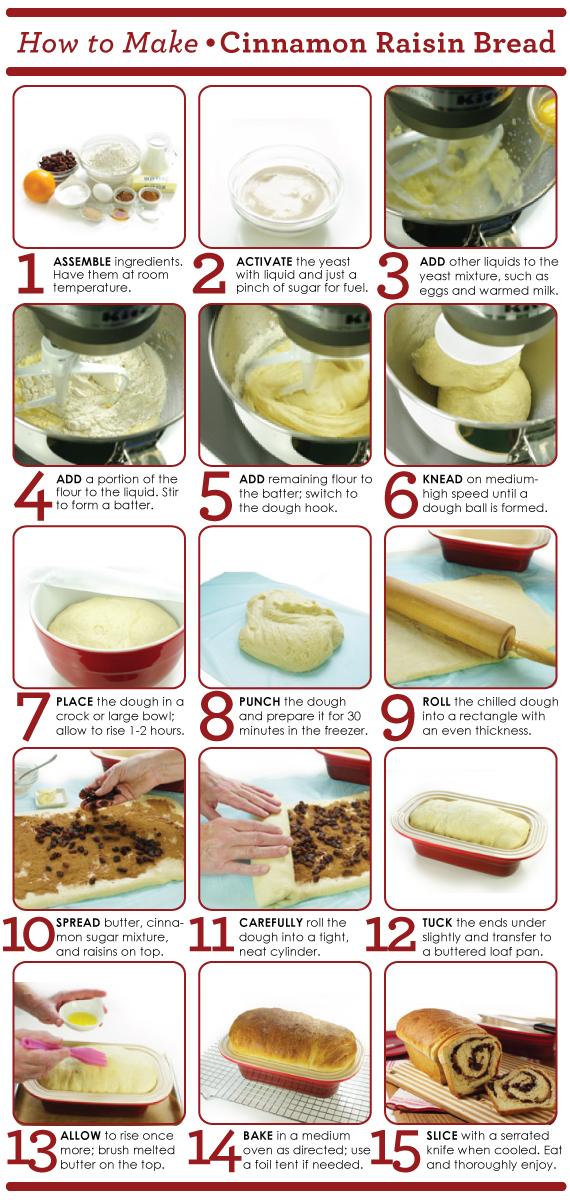
|
Fall's Spice: Cinnamon
| Cinnamon ranks in spice popularity right behind salt and pepper. It
flavors breads, pastries, pies, and all sorts of baked goods, but also
provides key character to curries, tagines, stews, casseroles, and so
much more.
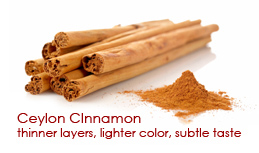 Cinnamon
is the inner bark of the cinnamon tree. Branches are cut from the tree,
the outer bark pounded away revealing the inner bark that peels away
and curls up. The bark peel is dried and cut into small lengths. Cinnamon
is the inner bark of the cinnamon tree. Branches are cut from the tree,
the outer bark pounded away revealing the inner bark that peels away
and curls up. The bark peel is dried and cut into small lengths.
We
find cinnamon in powdered form, and in a stick form, also known as a
cinnamon quill. Sticks of cinnamon keep their flavor longer, while
ground cinnamon has more potency. Store cinnamon tightly sealed in a
dry, cool, and dark place. Cinnamon will keep its flavor about six
months in powdered form, and about one year in stick form.
Variations
of cinnamon come from different species of the cinnamon tree, genus
Cinnamonum, and differ based on where the tree is grown. While there are
hundreds of variants, here are some more culinary cinnamons:
- Ceylon Cinnamon
- This cinnamon is considered the norm, or "true cinnamon" with subtle
characteristics that are considered most desirable and refined. It is
said to have a spicy, citrus quality. Ceylon cinnamon quills have
paper-thin layers and are easily ground.
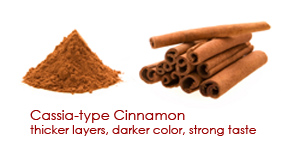 Cassia Cinnamon
- This Chinese variety is more common and less expensive than Ceylon
cinnamon. It is said to have a harsher flavor than the complex Ceylon
cinnamon. Cassia Cinnamon
- This Chinese variety is more common and less expensive than Ceylon
cinnamon. It is said to have a harsher flavor than the complex Ceylon
cinnamon.- Korintje Cinnamon - An
Indonesia cassia variety, this cinnamon has the least potency and is the
least expensive. Because of its availability, it is most frequently
used in baked goods even though it is considered a lesser product.
- Saigon Cinnamon - Grown in Vietnam, this cinnamon, also a cassia variant, has a bold, pungent flavor, and is available as powder or bark chips.
- Madagascar Cinnamon
- Marketed as an elite cinnamon, Madagascar cinnamon is the closest to
Ceylon Cinnamon. It has a lighter color and a subtly sweet taste. It
also shares the paper-thin bark layers of "true cinnamon."
|
Stand Up Power
| Many cooks comment, "I can't believe I waited this long to get a stand
mixer!" The might and versatility that a good stand mixer provides can
revolutionize your cooking routines. A stand mixer provides heavy-duty
power for the more strenuous tasks in the kitchen. If you're a baker,
mixing heavy doughs such as cookie doughs or bread doughs, can be
difficult by hand and beyond the ability of a hand mixer. A quality
stand mixer provides the necessary power to make mixing easy for the
baker, and the best part, mixing is a hands-free operation.
Considerations for Choosing a Stand Mixer - When considering a stand mixer, consider the following characteristics:
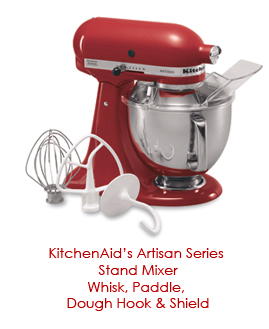 Size Matters
- Determine how you plan to use the mixer and match the size of the
bowl and the motor to your needs. Some mixers quantify in easy terms how
many loaves of bread it can make, how many dozen cookies, or pounds of
mashed potatoes. These real-world measurements help guide your choice. Size Matters
- Determine how you plan to use the mixer and match the size of the
bowl and the motor to your needs. Some mixers quantify in easy terms how
many loaves of bread it can make, how many dozen cookies, or pounds of
mashed potatoes. These real-world measurements help guide your choice.- Ease of Operation
- Assess the ease of operating the stand mixer. Are the On-Off and
speed controls easy to operate? Is it easy to place and remove the bowl?
Are the attachments easy to get on and off the drive shaft?
- The Bowl
- In addition to size considerations check that the bowl fits snuggly
in its place. A secure bowl that will withstand powerful mixing without
slipping or wobbling is important. Practice placing and removing the
bowl to judge the ease of working with the locking mechanisms.
- The Attachments
- Most stand mixers come with three standard attachments: a paddle for
mixing and stirring, a whisk for whipping tasks, and a dough hook for
mixing bread. Additionally, most upper-end mixers will also include a
shield that reduces splattering from the bowl, or loose flour from
flying around.
- The Color - Gone are
the days of white-only mixers. Mixers come in all kinds of colors and
finishes. Not only is the stand mixer a valuable tool, it looks good in
your kitchen while working or idling.
More Than a Mixer - Lending heavy-duty power to kitchen mixing tasks is reason enough to
invest in a stand mixer. However, the unit possesses additional "motor
skills." Specific attachments are available according to your cooking
interests: pasta rolling, grinding meats and foods, sausage stuffing,
juicing and straining, shredding, slicing, and even ice cream making.
|
Smart Bread-Making Tips
| Tip #1: For breads that have fillings, like the raisin
swirl bread or the sticky buns below, chill the dough overnight, or
freeze for 30 minutes. The cold will stiffen the dough, make it less
sticky, and increase your ability to roll it out to the desired size.
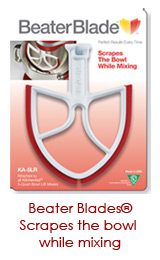 Tip #2: Blades® are an aftermarket product that incorporate a sturdy
rubber edge to the paddle attachment. The result is a mixing process
that does not require frequent stopping to scrape down the sides of the
mixing bowl. Beater Blades® are configured for all major brands and
specific models of stand mixers. Tip #2: Blades® are an aftermarket product that incorporate a sturdy
rubber edge to the paddle attachment. The result is a mixing process
that does not require frequent stopping to scrape down the sides of the
mixing bowl. Beater Blades® are configured for all major brands and
specific models of stand mixers.
Tip #3: When
mixing bread doughs in a stand mixer, allow time for the flour to be
absorbed and activated by the liquids. Sometimes doughs benefit from
standing a few minutes before the kneading step. An important chemical
reaction is taking place that cannot be hurried with faster mixing. The
moistened flour changes again during kneading. Knead the bread for the
full time required.
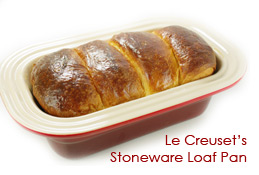 Tip #4: Bake breads in heavier metal bakeware that transfers heat evenly and
simultaneously insulates the outer crust. Alternatively, bake (and
serve) in stoneware that also evenly heats and protects the baking
bread. Tip #4: Bake breads in heavier metal bakeware that transfers heat evenly and
simultaneously insulates the outer crust. Alternatively, bake (and
serve) in stoneware that also evenly heats and protects the baking
bread.
Tip #5: Check your bread after about 20
minutes of baking. If it is browning too quickly, tent the pan with
aluminum foil set loosely on top.
Tip #6: Dissolve yeast in warm water or liquid that's between 105-115°F. Use an
instant read thermometer to check the temperature, or check with a drop
to the inside of your wrist; it should feel warm, not hot. Add
ingredients to the yeast mixture that are at room temperature; cold
eggs, for example, will shock the yeast at this early, tender stage and
stunt its growth.
|
Q & A's
|  Q: What is the difference between "active dry yeast" and "instant dry yeast?" Does it matter? Q: What is the difference between "active dry yeast" and "instant dry yeast?" Does it matter?
A: Active dry yeast is a more traditional dry yeast form and requires a dissolving or proofing step prior to adding the flour. 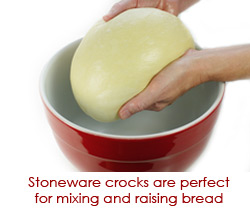 Instant
Yeast (aka "Fast-Rising®," "Rapid Rise®," "Quick Rise®" "Bread
Machine") has a smaller granule size and, therefore, absorbs liquids
much faster. It is generally not necessary to dissolve or proof instant
yeast. Most often, when using active yeast, two rises of the bread are
used, where with instant yeast, a short resting period followed by the
final rise is common. Four parts active yeast equates to three parts
instant yeast if substituting one for the other. Instant
Yeast (aka "Fast-Rising®," "Rapid Rise®," "Quick Rise®" "Bread
Machine") has a smaller granule size and, therefore, absorbs liquids
much faster. It is generally not necessary to dissolve or proof instant
yeast. Most often, when using active yeast, two rises of the bread are
used, where with instant yeast, a short resting period followed by the
final rise is common. Four parts active yeast equates to three parts
instant yeast if substituting one for the other.
Q: Why did grandma use an old crock as her bread-making bowl?
A: Grandma knew the secret of temperature when making bread. The magic of
bread making happens when the yeast grows and the glutens form and
stretch. Both taste and structure develop in the process. Yeast grows at
just the right bread making speed in warm room temperatures. Stoneware
provides an insulating capability that moderates the temperature of
rising bread from drafts and ambient temperature changes.
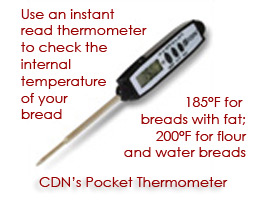
Q: How can I tell if my bread is done?
A: There are several ways to assess doneness. First of all, follow a
reliable recipe and its instructions for pan size, oven temperature, and
timing. Check the color of the baking bread. Invert a loaf and tap on
the bottom; it should sound hollow. Or, use an instant read thermometer.
Breads with primarily flour and water will be done when the internal
temperature registers around 200°F. Breads containing eggs or fat will
be done at around 185°F internally.
Q: What are the no-knead bread making methods that one hears so much about today?
A: Today's no-knead bread methods are actually a throwback to older bread
making techniques where time compensates for kneading through
"micro-kneading" action of the yeast. Check out last year's e-newsletter
on No-Knead Bread Making for more information and recipes.
|
| Cookbook Review | Baking, from My Home to Yours by Dorie Greenspan published by Houghton Mifflin, New York, NY. Copyright 2006. All rights reserved.
#1 in the 2010 Baker's Dozen List of "Essential Baking Cookbooks of All Time"
by the James Beard Foundation Book Awards Committee
2007 Winner of the James Beard Foundation's Cookbook Award
Baking and Desserts Category
| 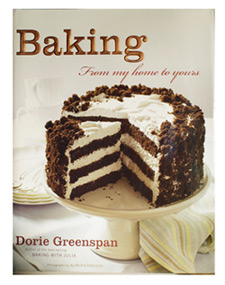 |
This
hefty book is worth its weight in gold! We're long time fans of Dorie
Greenspan and her earlier tome, Baking with Julia. In Baking, From My
Home to Yours, we're treated to expert guidance in all manner of baking
ranging from breakfast sweets, cookies, cakes, pies, tarts, "spoon
desserts," and, of course, breads. It's much more than a collection of
recipes that define the number of cups or teaspoons of this or that. She
lets you in on the artful side of baking. Her imaginative writing
paints a picture for such esoteric concepts as a "shaggy dough," or a
"silken batter." It's like having an expert over your shoulder
navigating baking nuances with you, teaching you texture, look, and the
changing character of your evolving creation. Her style of presentation
entertains as well as informs. The photographs by Alan Richardson
replete with many vintage-inspired scenes, completes the aptly crafted
recipe/stories. These recipes fall into the "trusted" category, the type
that always work, gain raves all-around, and become "true keepers."
This is a book that we always reach for when its time to turn on the
oven and bake! |
|
Three Fresh Bread Recipes
| Raisin Swirl Bread
View & Print
When
comfort food comes in a loaf, it's as cinnamon raisin bread. This
recipe produced a generous, delicious loaf with plenty of raisins, just
the right amount of cinnamon all captured in a swirl of bread. The bread
dough assembled easily and was a delight to handle. As hard as it is to
wait, it will slice best when cooled.
| 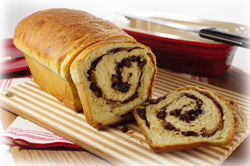 | |
Golden Brioche Loaves
View & Print
A
brioche is a bread boosted with plenty of eggs and butter. The result
is a very rich bread with plenty of taste. A stand mixer facilitates the
formation of the dough that requires a fair amount of mixing. The
flavors develop further through an overnight refrigeration step. It's
easier than it appears, and totally worth it when you take the first
bite of a toasted slice.
| 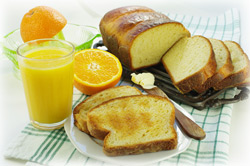 | |
Pecan Sticky Buns
View & Print
Based
on the brioche dough above, these pecan rolls rate top on our list, and
we consider ourselves sticky bun experts! The chilled brioche dough
rolls out well, and curls well around a filling of butter, cinnamon,
brown sugar, and white sugar. The dough pinwheels are placed on top of a
layer of caramel and pecans. Life is sweet with these buns on your
plate!
| 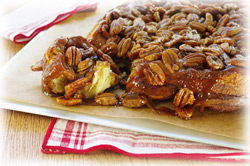 | |
Recipes from Baking, from My Home to Yours by Dorie Greenspan through permission of Houghton Mifflin, New York, NY. Copyright 2006. All rights reserved. |
|
|
James Beard said, "Good bread is the most fundamentally satisfying of
all foods; and good bread with fresh butter, the greatest of feasts." We
heartily agree!
|
Chris Beykirch and All the Staff at Love to Cook! 1211 N. Main Street Logan, UT 84341 435-752-9220/888-GADGET9 www.luvtocook.com |
|
|
|
|